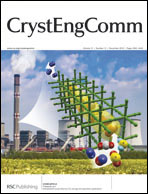In the present investigation, various copper(II)–alkali/alkaline earth metal ion heteronuclear complexes derived from N,N′-ethylenebis(3-ethoxysalicylaldimine) (H2L) have been studied. The syntheses, characterization and crystal structures of three [2 × 1 + 1 × 2] cocrystals [{CuIILLiI(H2O)2}{CuIIL}2](ClO4) (1), [{CuIILNaI(H2O)2}{CuIIL}2](dicyanamide) (2) and [{CuIILMgII(H2O)3}{CuIIL}2](NO3)2·H2O (3), one [3 × 1 + 5 × 1] double-decker–triple-decker cocrystal [{(CuIIL)2KI}(ClO4)]·[{(CuIIL)3KI2(μ-ClO4)}(ClO4)] (4), one dinuclear CuIIKI-based one-dimensional polymer [CuIILKI(μ-PF6)]n (5) and one hexametallic quadruple-decker compound [{(CuIIL)2RbI(μ-H2O)}2](BPh4)2·2CH3COCH3 (6) are reported. Compounds 1, 2, 3 and 6 crystallize in the triclinic crystal system (space group P![[1 with combining macron]](https://www.rsc.org/images/entities/char_0031_0304.gif) ), while the crystal systems of 4 and 5 are monoclinic (space group C2/c) and orthorhombic (space group P212121), respectively. The cocrystallization in 1–3 takes place through the encapsulation of coordinated water molecules into the O4 compartment of two mononuclear [CuIIL] moieties; both the coordinated water molecules are involved in the case of 1 and 2, while 2 of the 3 coordinated water molecules are involved for 3. In 4, the potassium(I) centre in the double-decker moiety is sandwiched in between two mononuclear [CuIIL] moieties, while each of the two potassium(I) centres in the triple-decker moiety are sandwiched in between a pair of two [CuIIL] moieties. The two potassium(I) centres in the triple-decker moiety are bridged by a perchlorate anion. In 5, two cis fluorine atoms from the hexafluorophosphate anion bridge the potassium(I) centres of the neighbouring dinuclear CuIIKI units to build up a one-dimensional polymer. The quadruple-decker hexanuclear [{(CuIIL)2RbI(μ-H2O)}2]2+ dication in 6 can be considered to consist of two trinuclear double-decker [(CuIIL)2RbI]+ moieties, interlinked by two bridging water molecules. Structural resemblance between the structures formed with LiI, NaI and MgII and those with 3d metal ions, the anion dependence of the topology of the copper(II)–potassium(I) complexes, cocrystallization in the presence of the potentially bridging dicyanamide anion, the first report of a one-dimensional polymer derived from H2L and an interesting example of a quadruple-decker complex, are the major outcomes of the present investigation. All in all, structural diversity in the H2L ligand system has been further enriched by some interesting structures in the present investigation.
), while the crystal systems of 4 and 5 are monoclinic (space group C2/c) and orthorhombic (space group P212121), respectively. The cocrystallization in 1–3 takes place through the encapsulation of coordinated water molecules into the O4 compartment of two mononuclear [CuIIL] moieties; both the coordinated water molecules are involved in the case of 1 and 2, while 2 of the 3 coordinated water molecules are involved for 3. In 4, the potassium(I) centre in the double-decker moiety is sandwiched in between two mononuclear [CuIIL] moieties, while each of the two potassium(I) centres in the triple-decker moiety are sandwiched in between a pair of two [CuIIL] moieties. The two potassium(I) centres in the triple-decker moiety are bridged by a perchlorate anion. In 5, two cis fluorine atoms from the hexafluorophosphate anion bridge the potassium(I) centres of the neighbouring dinuclear CuIIKI units to build up a one-dimensional polymer. The quadruple-decker hexanuclear [{(CuIIL)2RbI(μ-H2O)}2]2+ dication in 6 can be considered to consist of two trinuclear double-decker [(CuIIL)2RbI]+ moieties, interlinked by two bridging water molecules. Structural resemblance between the structures formed with LiI, NaI and MgII and those with 3d metal ions, the anion dependence of the topology of the copper(II)–potassium(I) complexes, cocrystallization in the presence of the potentially bridging dicyanamide anion, the first report of a one-dimensional polymer derived from H2L and an interesting example of a quadruple-decker complex, are the major outcomes of the present investigation. All in all, structural diversity in the H2L ligand system has been further enriched by some interesting structures in the present investigation.
![[1 with combining macron]](https://www.rsc.org/images/entities/char_0031_0304.gif) ), while the crystal systems of 4 and 5 are monoclinic (space
), while the crystal systems of 4 and 5 are monoclinic (space ![Graphical abstract: Tetrametallic [2 × 1 + 1 × 2], octametallic double-decker–triple-decker [5 × 1 + 3 × 1], hexametallic quadruple-decker and dimetallic-based one-dimensional complexes of copper(ii) and s block metal ions derived from N,N′-ethylenebis(3-ethoxysalicylaldimine)](/en/Image/Get?imageInfo.ImageType=GA&imageInfo.ImageIdentifier.ManuscriptID=C0CE00154F&imageInfo.ImageIdentifier.Year=2010)

 Please wait while we load your content...
Please wait while we load your content...